
Illustrative Math Alignment: Grade 6 Unit 2
Introducing Ratios
Lesson 14: Solving Equivalent Ratio Problems
Use the following Media4Math resources with this Illustrative Math lesson.
| Thumbnail Image | Title | Body | Curriculum Topic |
|---|---|---|---|
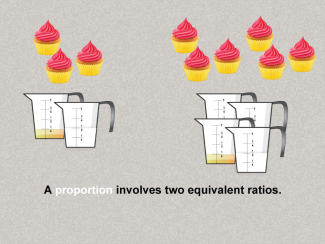
|
Math Clip Art--Ratios, Proportions, Percents--Proportions 02 |
Math Clip Art--Ratios, Proportions, Percents--Proportions 02TopicRatios, Proportions, and Percents DescriptionThis image illustrates proportions using two equivalent ratios, represented by measuring cups and cupcakes. It simplifies proportions to relatable everyday examples. It connects proportions to practical examples, emphasizing the real-world relevance. Proportions are a foundational concept in mathematics, connecting ratios to real-world applications. Examples like those in this collection help students visualize and reason about proportional relationships in meaningful contexts, solidifying their understanding. |
Proportions |
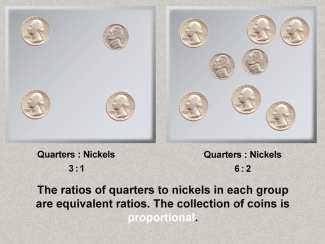
|
Math Clip Art--Ratios, Proportions, Percents--Proportions 03 |
Math Clip Art--Ratios, Proportions, Percents--Proportions 03TopicRatios, Proportions, and Percents DescriptionThis image uses coins to demonstrate proportions. The image compares groups of quarters and nickels to highlight equivalent ratios (3:1 and 6:2). It solidifies the concept of equivalent ratios through another real-life example, reinforcing the idea. Proportions are a foundational concept in mathematics, connecting ratios to real-world applications. Examples like those in this collection help students visualize and reason about proportional relationships in meaningful contexts, solidifying their understanding. |
Proportions |
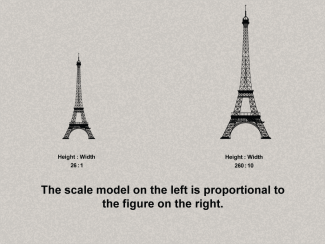
|
Math Clip Art--Ratios, Proportions, Percents--Proportions 04 |
Math Clip Art--Ratios, Proportions, Percents--Proportions 04TopicRatios, Proportions, and Percents DescriptionThis image demonstrates proportions through a scale model example, comparing the height and width ratios of the Eiffel Tower in two scales. It highlights the application of proportions in scaling and models, bridging abstract and practical understanding. Proportions are a foundational concept in mathematics, connecting ratios to real-world applications. Examples like those in this collection help students visualize and reason about proportional relationships in meaningful contexts, solidifying their understanding. |
Proportions |
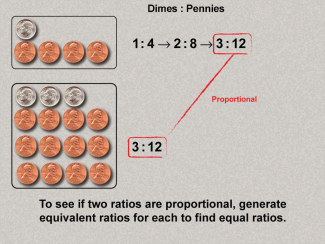
|
Math Clip Art--Ratios, Proportions, Percents--Proportions 05 |
Math Clip Art--Ratios, Proportions, Percents--Proportions 05TopicRatios, Proportions, and Percents DescriptionThis image shows proportionality between dimes and pennies using equivalent ratios (1:4 and 3:12). Mathematical steps verify proportionality. It introduces proportional reasoning and calculation steps to ensure clarity in identifying proportional relationships. Proportions are a foundational concept in mathematics, connecting ratios to real-world applications. Examples like those in this collection help students visualize and reason about proportional relationships in meaningful contexts, solidifying their understanding. |
Proportions |
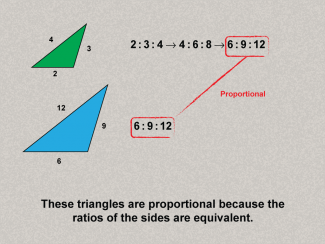
|
Math Clip Art--Ratios, Proportions, Percents--Proportions 06 |
Math Clip Art--Ratios, Proportions, Percents--Proportions 06TopicRatios, Proportions, and Percents DescriptionThis image presents proportional triangles, with side lengths maintaining equivalent ratios (2:3:4 and 6:9:12). It demonstrates geometric applications of proportions, extending the concept to shapes and measurements. Proportions are a foundational concept in mathematics, connecting ratios to real-world applications. Examples like those in this collection help students visualize and reason about proportional relationships in meaningful contexts, solidifying their understanding. |
Proportions |
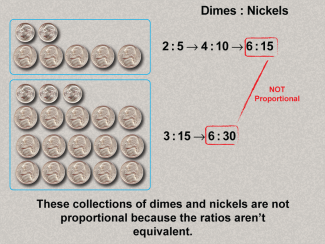
|
Math Clip Art--Ratios, Proportions, Percents--Proportions 07 |
Math Clip Art--Ratios, Proportions, Percents--Proportions 07TopicRatios, Proportions, and Percents DescriptionThis image contrasts proportionality with non-proportional groups of coins (dimes and nickels). Ratios differ, clarifying when proportions do not exist. It explains non-proportionality to deepen understanding of proportional relationships. Proportions are a foundational concept in mathematics, connecting ratios to real-world applications. Examples like those in this collection help students visualize and reason about proportional relationships in meaningful contexts, solidifying their understanding. |
Proportions |
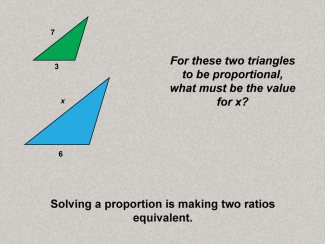
|
Math Clip Art--Ratios, Proportions, Percents--Proportions 08 |
Math Clip Art--Ratios, Proportions, Percents--Proportions 08TopicRatios, Proportions, and Percents DescriptionThis image poses a question about proportional triangles, asking for the missing value (x) to maintain proportionality. It introduces problem-solving involving proportions, encouraging engagement and application. Proportions are a foundational concept in mathematics, connecting ratios to real-world applications. Examples like those in this collection help students visualize and reason about proportional relationships in meaningful contexts, solidifying their understanding. |
Proportions |
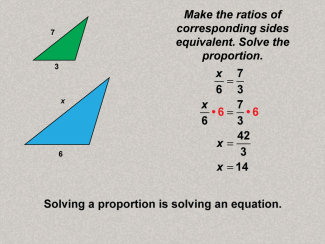
|
Math Clip Art--Ratios, Proportions, Percents--Proportions 09 |
Math Clip Art--Ratios, Proportions, Percents--Proportions 09TopicRatios, Proportions, and Percents DescriptionThis image solves the posed proportion problem by finding the value of x using equivalent ratios (x/6 = 7/3). It breaks down the process of solving proportions, reinforcing mathematical reasoning. Proportions are a foundational concept in mathematics, connecting ratios to real-world applications. Examples like those in this collection help students visualize and reason about proportional relationships in meaningful contexts, solidifying their understanding. |
Proportions |

|
Math Clip Art--Ratios, Proportions, Percents--Proportions 10 |
Math Clip Art--Ratios, Proportions, Percents--Proportions 10TopicRatios, Proportions, and Percents DescriptionThis image demonstrates proportionality in coins by calculating the number of nickels required for proportional groups (2/5 = 6/x). It closes the sequence with a real-world problem, consolidating the topic and providing a practical application. Proportions are a foundational concept in mathematics, connecting ratios to real-world applications. Examples like those in this collection help students visualize and reason about proportional relationships in meaningful contexts, solidifying their understanding. |
Proportions |

|
Math Clip Art--Ratios, Proportions, Percents--Rates 01 |
Math Clip Art--Ratios, Proportions, Percents--Rates 01TopicRatios, Proportions, and Percents DescriptionThe image shows a hurdler jumping over a hurdle, with an overlay of the golden ratio (1.618). It introduces the concept of rates by visually showing motion and proportions. This image sets the stage for understanding rates as a mathematical relationship and connects to the idea of proportion and efficiency, aligning with rates' use in describing relationships. Ratios, Proportions, and Percents focuses on understanding and applying the concept of rates, which are comparisons of two quantities with different units. |
Ratios and Rates |

|
Math Clip Art--Ratios, Proportions, Percents--Rates 02 |
Math Clip Art--Ratios, Proportions, Percents--Rates 02TopicRatios, Proportions, and Percents DescriptionThe image depicts a gas station with the formula Rate = a / b, where b ≠ 0, defining rate as a ratio of two different units. It introduces the formal definition of rates, providing a foundation for subsequent examples that apply this definition in real-world contexts. Ratios, Proportions, and Percents focuses on understanding and applying the concept of rates, which are comparisons of two quantities with different units. |
Ratios and Rates |

|
Math Clip Art--Ratios, Proportions, Percents--Rates 03 |
Math Clip Art--Ratios, Proportions, Percents--Rates 03TopicRatios, Proportions, and Percents DescriptionThe image shows a car at a gas station with the formula Speed = Distance / Time, explaining speed as a specific example of rate. It connects the abstract concept of rates to a concrete example (speed), making the topic relatable and easier to understand. Ratios, Proportions, and Percents focuses on understanding and applying the concept of rates, which are comparisons of two quantities with different units. |
Ratios and Rates |

|
Math Clip Art--Ratios, Proportions, Percents--Rates 04 |
Math Clip Art--Ratios, Proportions, Percents--Rates 04TopicRatios, Proportions, and Percents DescriptionThe image highlights a gasoline pump with the formula Rate = Dollars / Gallon, illustrating the cost of gasoline as an example of rate. It applies the concept of rates to another common scenario, reinforcing the idea of rates in daily life and extending understanding from speed to cost per unit. Ratios, Proportions, and Percents focuses on understanding and applying the concept of rates, which are comparisons of two quantities with different units. |
Ratios and Rates |

|
Math Clip Art--Ratios, Proportions, Percents--Rates 05 |
Math Clip Art--Ratios, Proportions, Percents--Rates 05TopicRatios, Proportions, and Percents DescriptionThe image depicts a car with the formula Fuel Efficiency Rate = Miles / Gallon, explaining how fuel efficiency is measured as a rate. It introduces a third example of rates, connecting to environmental and economic considerations, and further solidifying understanding. Ratios, Proportions, and Percents focuses on understanding and applying the concept of rates, which are comparisons of two quantities with different units. |
Ratios and Rates |

|
Math Clip Art--Ratios, Proportions, Percents--Rates 06 |
Math Clip Art--Ratios, Proportions, Percents--Rates 06TopicRatios, Proportions, and Percents DescriptionThe image shows a fruit market with the formula Rate = Dollars / Pound, illustrating the cost of fruits and vegetables per unit weight. It expands the application of rates to another familiar scenario, demonstrating versatility in its use across contexts. Ratios, Proportions, and Percents focuses on understanding and applying the concept of rates, which are comparisons of two quantities with different units. |
Ratios and Rates |

|
Math Clip Art--Ratios, Proportions, Percents--Rates 07 |
Math Clip Art--Ratios, Proportions, Percents--Rates 07TopicRatios, Proportions, and Percents DescriptionThe image shows a carton of eggs priced at $4 a dozen, defining a unit rate where b = 1, expressed as whole numbers or decimals. It introduces the concept of unit rates, a special type of rate, laying the groundwork for calculations in subsequent images. Ratios, Proportions, and Percents focuses on understanding and applying the concept of rates, which are comparisons of two quantities with different units. |
Ratios and Rates |

|
Math Clip Art--Ratios, Proportions, Percents--Rates 08 |
Math Clip Art--Ratios, Proportions, Percents--Rates 08TopicRatios, Proportions, and Percents DescriptionThe image features lemons priced at $2.50 for 5, with the calculation Unit Rate = 2.50 / 5 = 0.50 per lemon. It provides a step-by-step calculation of unit rates, reinforcing the concept introduced earlier with practical application. Ratios, Proportions, and Percents focuses on understanding and applying the concept of rates, which are comparisons of two quantities with different units. |
Ratios and Rates |

|
Math Clip Art--Ratios, Proportions, Percents--Rates 09 |
Math Clip Art--Ratios, Proportions, Percents--Rates 09TopicRatios, Proportions, and Percents DescriptionThe image illustrates the cost of 5 pounds of ground beef at $15.75, with the calculation Unit Rate = 15.75 / 5 = 3.25 per pound. It demonstrates another example of calculating unit rates, solidifying the learner's ability to perform similar calculations. Ratios, Proportions, and Percents focuses on understanding and applying the concept of rates, which are comparisons of two quantities with different units. |
Ratios and Rates |

|
Math Clip Art--Ratios, Proportions, Percents--Rates 10 |
Math Clip Art--Ratios, Proportions, Percents--Rates 10TopicRatios, Proportions, and Percents DescriptionThe image shows a runner covering 8 miles in 1.25 hours, with the calculation Speed = 8 / 1.25 = 6.4 miles/hour. It reinforces the speed example from earlier, providing another opportunity to apply the concept of rates to motion. Ratios, Proportions, and Percents focuses on understanding and applying the concept of rates, which are comparisons of two quantities with different units. |
Ratios and Rates |

|
Math Clip Art--Ratios, Proportions, Percents--Ratios 01 |
Math Clip Art--Ratios, Proportions, Percents--Ratios 01TopicRatios, Proportions, and Percents DescriptionThis image establishes the mathematical foundation for understanding ratios with an iconic example. Ratios, Proportions, and Percents is a fundamental concept in mathematics that helps students understand proportional reasoning, scaling, and comparative analysis. These examples provide a bridge between abstract mathematical principles and real-world applications, helping students grasp the utility of ratios. |
Ratios and Rates |

|
Math Clip Art--Ratios, Proportions, Percents--Ratios 02 |
Math Clip Art--Ratios, Proportions, Percents--Ratios 02TopicRatios, Proportions, and Percents DescriptionDefinition of a ratio as a relationship between two quantities using sports balls. It introduces the concept of ratios in an accessible and relatable way. Ratios, Proportions, and Percents is a fundamental concept in mathematics that helps students understand proportional reasoning, scaling, and comparative analysis. These examples provide a bridge between abstract mathematical principles and real-world applications, helping students grasp the utility of ratios. |
Ratios and Rates |

|
Math Clip Art--Ratios, Proportions, Percents--Ratios 03 |
Math Clip Art--Ratios, Proportions, Percents--Ratios 03TopicRatios, Proportions, and Percents DescriptionVisual example of ratios using soccer balls and basketballs, expressed as 5:2, 5 to 2, and 5 / 2. Illustrates how ratios can be represented in multiple formats. Ratios, Proportions, and Percents is a fundamental concept in mathematics that helps students understand proportional reasoning, scaling, and comparative analysis. These examples provide a bridge between abstract mathematical principles and real-world applications, helping students grasp the utility of ratios. |
Ratios and Rates |

|
Math Clip Art--Ratios, Proportions, Percents--Ratios 04 |
Math Clip Art--Ratios, Proportions, Percents--Ratios 04TopicRatios, Proportions, and Percents DescriptionA table summarizing different ratios derived from the group of balls, e.g., soccer to baseball or soccer to basketball. Shows how to systematically calculate and organize ratios from a dataset. Ratios, Proportions, and Percents is a fundamental concept in mathematics that helps students understand proportional reasoning, scaling, and comparative analysis. These examples provide a bridge between abstract mathematical principles and real-world applications, helping students grasp the utility of ratios. |
Ratios and Rates |

|
Math Clip Art--Ratios, Proportions, Percents--Ratios 05 |
Math Clip Art--Ratios, Proportions, Percents--Ratios 05TopicRatios, Proportions, and Percents DescriptionSimplification of ratios in the table, e.g., 4 / 2 becomes 2 / 1. Highlights the importance of simplifying ratios for clarity and consistency. Ratios, Proportions, and Percents is a fundamental concept in mathematics that helps students understand proportional reasoning, scaling, and comparative analysis. These examples provide a bridge between abstract mathematical principles and real-world applications, helping students grasp the utility of ratios. |
Ratios and Rates |

|
Math Clip Art--Ratios, Proportions, Percents--Ratios 06 |
Math Clip Art--Ratios, Proportions, Percents--Ratios 06TopicRatios, Proportions, and Percents DescriptionApplication of ratios to geometric shapes (circles, triangles, hexagons) with a table of ratios. Extends the concept of ratios to other objects, demonstrating versatility. Ratios, Proportions, and Percents is a fundamental concept in mathematics that helps students understand proportional reasoning, scaling, and comparative analysis. These examples provide a bridge between abstract mathematical principles and real-world applications, helping students grasp the utility of ratios. |
Ratios and Rates |

|
Math Clip Art--Ratios, Proportions, Percents--Ratios 07 |
Math Clip Art--Ratios, Proportions, Percents--Ratios 07TopicRatios, Proportions, and Percents DescriptionSimplified ratios in the table for geometric shapes. Reinforces the practice of simplifying ratios for better comprehension. Ratios, Proportions, and Percents is a fundamental concept in mathematics that helps students understand proportional reasoning, scaling, and comparative analysis. These examples provide a bridge between abstract mathematical principles and real-world applications, helping students grasp the utility of ratios. |
Ratios and Rates |

|
Math Clip Art--Ratios, Proportions, Percents--Ratios 08 |
Math Clip Art--Ratios, Proportions, Percents--Ratios 08TopicRatios, Proportions, and Percents DescriptionExample of a three-term ratio (Red : Yellow : Blue = 6 : 4 : 3) using lollipops. Expands understanding of ratios to include three quantities. Ratios, Proportions, and Percents is a fundamental concept in mathematics that helps students understand proportional reasoning, scaling, and comparative analysis. These examples provide a bridge between abstract mathematical principles and real-world applications, helping students grasp the utility of ratios. |
Ratios and Rates |

|
Math Clip Art--Ratios, Proportions, Percents--Ratios 09 |
Math Clip Art--Ratios, Proportions, Percents--Ratios 09TopicRatios, Proportions, and Percents DescriptionThree-term ratios applied to a recipe: Flour : Sugar : Milk = 3 : 2 : 1. Connects ratios to real-world applications, specifically in cooking. Ratios, Proportions, and Percents is a fundamental concept in mathematics that helps students understand proportional reasoning, scaling, and comparative analysis. These examples provide a bridge between abstract mathematical principles and real-world applications, helping students grasp the utility of ratios. |
Ratios and Rates |

|
Math Clip Art--Ratios, Proportions, Percents--Ratios 10 |
Math Clip Art--Ratios, Proportions, Percents--Ratios 10TopicRatios, Proportions, and Percents DescriptionFractions in ratios: Milk to Water = 1/4 : 1/2, simplified to 1 : 2. Demonstrates handling fractional ratios and simplifying them to whole numbers. Ratios, Proportions, and Percents is a fundamental concept in mathematics that helps students understand proportional reasoning, scaling, and comparative analysis. These examples provide a bridge between abstract mathematical principles and real-world applications, helping students grasp the utility of ratios. |
Ratios and Rates |

|
Math Clip Art--Ratios, Proportions, Percents--Ratios 11 |
Math Clip Art--Ratios, Proportions, Percents--Ratios 11TopicRatios, Proportions, and Percents DescriptionDemonstrates equivalent ratios by simplifying fractions for Red:Green (4:2 to 2:1) and Strawberries:Lemons (6:3 to 2:1). Emphasizes the concept of equivalent ratios by showing how they simplify to the same value, reinforcing previous examples. Ratios, Proportions, and Percents is a fundamental concept in mathematics that helps students understand proportional reasoning, scaling, and comparative analysis. These examples provide a bridge between abstract mathematical principles and real-world applications, helping students grasp the utility of ratios. |
Ratios and Rates |
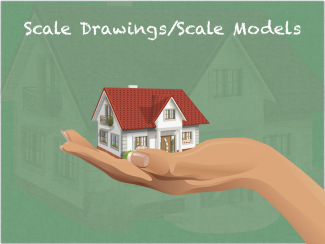
|
Math Clip Art--Ratios, Proportions, Percents--Scale Drawings and Scale Models 01 |
Math Clip Art--Ratios, Proportions, Percents--Scale Drawings and Scale Models 01
This is part of a collection of math clip art images that explain different aspects of ratios, proportions, and percents. |
Proportions |
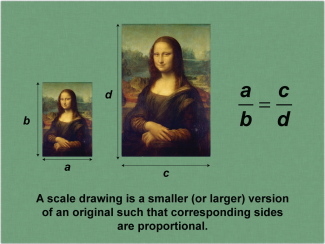
|
Math Clip Art--Ratios, Proportions, Percents--Scale Drawings and Scale Models 02 |
Math Clip Art--Ratios, Proportions, Percents--Scale Drawings and Scale Models 02
This is part of a collection of math clip art images that explain different aspects of ratios, proportions, and percents. |
Proportions |
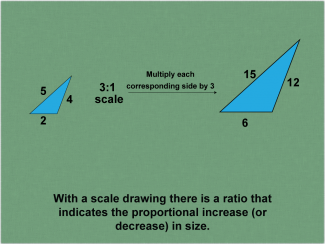
|
Math Clip Art--Ratios, Proportions, Percents--Scale Drawings and Scale Models 03 |
Math Clip Art--Ratios, Proportions, Percents--Scale Drawings and Scale Models 03
This is part of a collection of math clip art images that explain different aspects of ratios, proportions, and percents. |
Proportions |
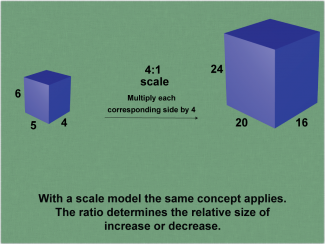
|
Math Clip Art--Ratios, Proportions, Percents--Scale Drawings and Scale Models 04 |
Math Clip Art--Ratios, Proportions, Percents--Scale Drawings and Scale Models 04
This is part of a collection of math clip art images that explain different aspects of ratios, proportions, and percents. |
Proportions |
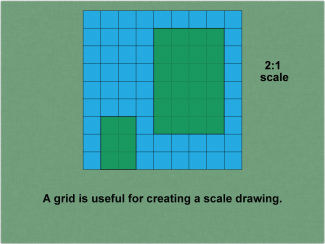
|
Math Clip Art--Ratios, Proportions, Percents--Scale Drawings and Scale Models 05 |
Math Clip Art--Ratios, Proportions, Percents--Scale Drawings and Scale Models 05
This is part of a collection of math clip art images that explain different aspects of ratios, proportions, and percents. |
Proportions |

|
Math Clip Art--Ratios, Proportions, Percents--Scale Drawings and Scale Models 06 |
Math Clip Art--Ratios, Proportions, Percents--Scale Drawings and Scale Models 06
This is part of a collection of math clip art images that explain different aspects of ratios, proportions, and percents. |
Proportions |

|
Math Example--Ratios, Proportions, and Percents--Solving Proportions: Example 1 |
Math Example--Ratios, Proportions, and Percents--Solving Proportions: Example 1TopicRatios, Proportions, and Percents DescriptionThis example demonstrates how to solve a proportion problem where two ratios a:b and c:d are proportional. Given the values b = 3, c = 4, and d = 6, we need to find the value of a. The proportion is set up as a / 3 = 4 / 6, which is then solved to find that a = 2. |
Proportions |

|
Math Example--Ratios, Proportions, and Percents--Solving Proportions: Example 10 |
Math Example--Ratios, Proportions, and Percents--Solving Proportions: Example 10TopicRatios, Proportions, and Percents DescriptionThis example illustrates solving a proportion problem using similar triangles with algebraic expressions. Two triangles are shown, one with sides of 6 and 9, and the other with sides of 2x and 2x + 9. The problem requires setting up a proportion: 6 / 9 = 2x / (2x + 9). Solving this equation leads to x = 9, which then allows us to find the side lengths of 18 and 27. |
Proportions |

|
Math Example--Ratios, Proportions, and Percents--Solving Proportions: Example 11 |
Math Example--Ratios, Proportions, and Percents--Solving Proportions: Example 11TopicRatios, Proportions, and Percents DescriptionThis example demonstrates solving a proportion problem using similar right triangles. Two right triangles are shown, one with legs of 7 and 9, and the other with legs of 14 and x. The problem requires finding the length of side x by setting up a proportion based on the similar triangles: 7 / 9 = 14 / x. Solving this equation leads to x = 18. |
Proportions |

|
Math Example--Ratios, Proportions, and Percents--Solving Proportions: Example 12 |
Math Example--Ratios, Proportions, and Percents--Solving Proportions: Example 12TopicRatios, Proportions, and Percents DescriptionThis example illustrates solving a proportion problem using similar right triangles with algebraic expressions. Two right triangles are shown, one with legs of 5 and 8, and the other with legs of 2x and (2x + 6). The problem requires setting up a proportion: 5 / 8 = 2x / (2x + 6). Solving this equation leads to x = 5, which then allows us to find the side lengths of 10 and 16. |
Proportions |

|
Math Example--Ratios, Proportions, and Percents--Solving Proportions: Example 13 |
Math Example--Ratios, Proportions, and Percents--Solving Proportions: Example 13TopicRatios, Proportions, and Percents DescriptionThis example demonstrates solving a proportion problem using similar right triangles with special angles (30°-60°-90°). Two triangles are shown, with the smaller one having sides of 6√3 and 6, and the larger one having sides of x and 12. The problem requires finding the length of side x by setting up a proportion: (6√3) / 6 = x / 12. Solving this equation leads to x = 12√3. |
Proportions |

|
Math Example--Ratios, Proportions, and Percents--Solving Proportions: Example 14 |
Math Example--Ratios, Proportions, and Percents--Solving Proportions: Example 14TopicRatios, Proportions, and Percents DescriptionThis example illustrates solving a proportion problem using similar right triangles with special angles (30°-60°-90°) and algebraic expressions. Two triangles are shown, with the smaller one having sides of 16 and 8, and the larger one having sides of (3x + 4) and 2x. The problem requires setting up a proportion: 16 / 8 = (3x + 4) / 2x. Solving this equation leads to x = 4, which then allows us to find the side lengths of 8 and 16. |
Proportions |

|
Math Example--Ratios, Proportions, and Percents--Solving Proportions: Example 15 |
Math Example--Ratios, Proportions, and Percents--Solving Proportions: Example 15TopicRatios, Proportions, and Percents DescriptionThis example demonstrates solving a proportion problem using similar right triangles. Two right triangles are shown, with the smaller one having sides of 4 and 3, and the larger one having sides of x and 12. The problem requires finding the length of side x by setting up a proportion: 4 / 3 = x / 12. Solving this equation leads to x = 16. |
Proportions |

|
Math Example--Ratios, Proportions, and Percents--Solving Proportions: Example 16 |
Math Example--Ratios, Proportions, and Percents--Solving Proportions: Example 16TopicRatios, Proportions, and Percents DescriptionThis example illustrates solving a proportion problem using similar right triangles with algebraic expressions. Two right triangles are shown, with the smaller one having sides of (3x + 4) and 6, and the larger one having sides of 3x and 3x. The problem requires setting up a proportion: 8 / 6 = (3x + 4) / 3x. Solving this equation leads to x = 4, which then allows us to find the side lengths of 12 and 16. |
Proportions |

|
Math Example--Ratios, Proportions, and Percents--Solving Proportions: Example 17 |
Math Example--Ratios, Proportions, and Percents--Solving Proportions: Example 17TopicRatios, Proportions, and Percents DescriptionThis example demonstrates solving a proportion problem using similar right triangles. Two right triangles are shown, with the left one having sides of 12 and 5, and the right one having sides of x and 15. The problem requires finding the length of side x by setting up a proportion: 12 / 5 = x / 15. Solving this equation leads to x = 36. |
Proportions |

|
Math Example--Ratios, Proportions, and Percents--Solving Proportions: Example 18 |
Math Example--Ratios, Proportions, and Percents--Solving Proportions: Example 18TopicRatios, Proportions, and Percents DescriptionThis example illustrates solving a proportion problem using similar right triangles with algebraic expressions. Two right triangles are shown, with the left one having sides of 12 and 5, and the right one having sides of 10x + 8 and 5x. The problem requires setting up a proportion: 12 / 5 = (10x + 8) / 5x. Solving this equation leads to x = 4, which then allows us to find the side lengths of 20 and 48. |
Proportions |

|
Math Example--Ratios, Proportions, and Percents--Solving Proportions: Example 19 |
Math Example--Ratios, Proportions, and Percents--Solving Proportions: Example 19TopicRatios, Proportions, and Percents DescriptionThis example demonstrates solving a proportion problem using similar isosceles right triangles. Two 45-45-90 triangles are shown, with one having sides labeled y and 5√2, and the other having sides labeled x and 12. The problem requires finding the lengths of both x and y using the special properties of isosceles right triangles and proportions. |
Proportions |

|
Math Example--Ratios, Proportions, and Percents--Solving Proportions: Example 2 |
Math Example--Ratios, Proportions, and Percents--Solving Proportions: Example 2TopicRatios, Proportions, and Percents DescriptionThis example illustrates solving a proportion where b is expressed as x + 1, and c and d are given constants (c = 3, d = 2). The goal is to solve for a using the proportion a / b = c / d. By substituting the known values, we set up the equation a / (x + 1) = 3 / 2 and solve for a, resulting in the expression a = (3(x + 1)) / 2. |
Proportions |

|
Math Example--Ratios, Proportions, and Percents--Solving Proportions: Example 20 |
Math Example--Ratios, Proportions, and Percents--Solving Proportions: Example 20TopicRatios, Proportions, and Percents DescriptionThis example illustrates solving a proportion problem using similar isosceles right triangles with algebraic expressions. Two 45-45-90 triangles are shown, with one having sides labeled 15√2 and 15, and the other having sides labeled √2 * 5x and y. The problem requires finding the length of y in terms of x using the special properties of isosceles right triangles and proportions. |
Proportions |

|
Math Example--Ratios, Proportions, and Percents--Solving Proportions: Example 21 |
Math Example--Ratios, Proportions, and Percents--Solving Proportions: Example 21TopicRatios, Proportions, and Percents DescriptionThis example demonstrates solving a proportion problem using similar isosceles triangles. Two isosceles triangles are shown, with the smaller one having sides of 30 and 16, and the larger one having sides of x and 20. The problem requires finding the length of side x by setting up a proportion: 30 / 16 = x / 20. Solving this equation leads to x = 37.5. |
Proportions |